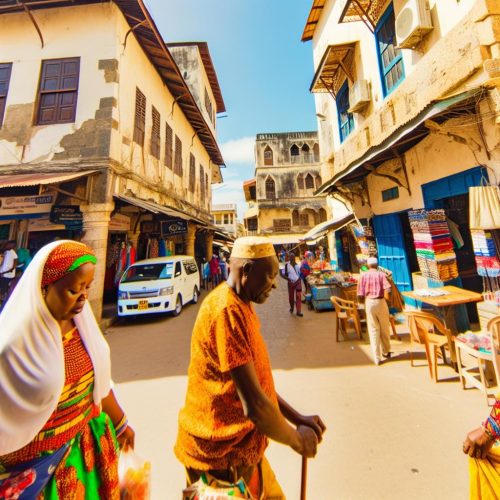Mombasa Old Town: A Historical and Cultural Gem
Mombasa Old Town, situated on the southeastern coast of Kenya, is a place steeped in the rich tapestry of history and culture. Its significance as an area that reflects the diverse influences of various cultures over the centuries makes it an enthralling destination for individuals eager to understand the coastal region’s heritage. The old town, surrounded by a warm Indian Ocean breeze, stands as a living museum of multi-ethnic interactions and their tangible imprints left on architecture, languages, and traditions.
Historical Background
Dating back to around the 14th century, Mombasa Old Town has been a central stage for trade and cultural exchanges in the region. Its history is a captivating tale of interaction and assimilation, presenting a blend of African, Arab, Persian, Indian, and European influences. Mombasa’s role as a crucial port city led to its development as a melting pot of cultures. This historical significance is depicted in the town’s layout and its functionality as a hub for merchants from around the world, who brought with them their unique customs, beliefs, and architectural styles.
Architecture
The architecture of Mombasa Old Town stands as a testament to its rich history and cultural amalgamation. The town is renowned for its distinctive architecture, which includes intricate carvings, wooden balconies, and ornate doors. Strolling through its narrow winding streets, one can observe the artistry of Swahili architecture, characterized by its use of coral stone—a material native to the coastal region. These architectural gems highlight the great skill and craftsmanship handed down through generations, offering a glimpse into the aesthetics that have adorned this town for centuries. Unique features such as latticed windows and decorative doorways showcase the blend of Middle Eastern and African influences, creating a picturesque setting reminiscent of a bygone era.
Cultural Significance
The cultural mosaic of Mombasa Old Town is reflected in its vibrant and diverse community. Home to several communities, including the Swahili people—who are the dominant cultural group—the old town’s traditions and cultural expressions are very much alive. The cultural heritage manifests in daily life through various forms such as food, clothing, and festivals, which harmoniously combine African, Arabic, and Indian influences. The locals continue to practice traditional crafts and trades, significantly contributing to their cultural identity preservation. Craftsmen skilled in metalwork and woodcarving create beautiful items that reflect the town’s eclectic mix of cultural heritages.
Fort Jesus
Among the notable landmarks in Mombasa Old Town, Fort Jesus stands out as a UNESCO World Heritage site. Constructed by the Portuguese in the late 16th century, its purpose was to protect the port of Mombasa from invasion. Over the centuries, Fort Jesus has been a pivotal military and political stronghold for several colonial powers such as the Omanis and the British. Today, it has been transformed into a museum that houses numerous artifacts and exhibits, offering a detailed account of Mombasa’s history and its people. For visitors, exploring Fort Jesus provides a fascinating journey through the pages of history, detailing stories of conquest, defense, and cultural crossover.
The Swahili Language
One of the vibrant threads in the cultural tapestry of Mombasa Old Town is the Swahili language. This language, which has its origins in the coastal areas of East Africa, is extensively spoken in this part of Mombasa. It serves as a unifying language that bridges the diverse communities residing in the region. Rich in oral tradition, the Swahili language contributes valuable insights into the daily lives and heritage of the Old Town’s inhabitants. Through stories, songs, and poems, Swahili serves as a living transmission of cultural values and social norms, offering a window into the communal and individual contributions to survival and existence in this historic town.
Exploring Mombasa Old Town
Exploring Mombasa Old Town offers a glimpse into both its rich past and its vibrant present. Visitors have the opportunity to engage with local guides who can enrich the experience with in-depth narratives and detailed insights into the town’s historical events and cultural practices. These guides are well-versed in the nuances of the town’s history and can reveal fascinating stories about it.
Moreover, various shops and markets scattered throughout the town provide excellent opportunities for visitors to purchase locally made crafts and to sample traditional Swahili cuisine. Items such as intricate wood carvings, hand-woven textiles, and colorful jewelry are not only souvenirs but pieces of art that encapsulate the area’s history. The markets bustled with aromatic spices and maritime delicacies, offering a taste of the intertwining cultures that define Mombasa.
For those interested in delving further into the history and cultural significance of Mombasa Old Town, a wealth of resources is readily accessible. Interested individuals can explore local travel sites and cultural heritage pages that offer extensive information on this fascinating area, assisting in planning visits and exploring its myriad attractions. By understanding Mombasa’s intricate history and vibrant culture, visitors can appreciate the deep-seated traditions and livelihoods of the Old Town’s inhabitants.
